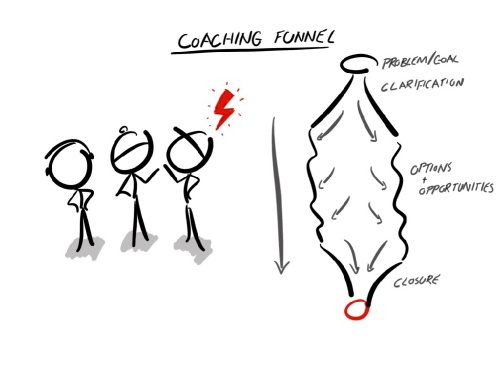Coaching Funnel
This coaching technique is described in Coaching Questions: A Coach’s Guide To Powerful Asking Skills by Tony Stoltzfus[15] and is intended as a framework for a coachee and a coach to discuss a goal or aspiration, which options are available and which actions are appropriate for the coachee to work towards their goals.
Step 1: Clarification
This technique starts with an opening goal or aspiration stated by the coachee. It is usually good for the coachee to explore why they want to achieve this goal with encouragement and assistance from the coach to understand what they want to get from the exercise, what their underlying drivers are, does the goal change from their initial assumption, and is this still something that they want to pursue.
Step 2: Options and Opportunities
As the discussion begins to progress the coach should encourage the coachee to expand and explore the options available to them as well as the potential opportunities that they can leverage, and any potential blockers that may affect the coachee's progress towards their goals. After a while the discussion about possibilities begins to wane and a natural transition towards which options are most relevant to the coachee and their situation begin to emerge.
Step 3: Realistic Options
At this point converging upon which options are most likely to be achievable by the coachee can then be distilled into actions that the coachee wants to take towards their goals. Itemising these actions then forms a planned approach for the coachee for them to realise their goals and often incorporates timings and checkpoints for them to evaluate where they are on their journey.
Step 4: Closure
The conversation wraps up with an agreed plan that has been derived by the coachee with assistance from the coach and possible follow up meetings with the coach for the coachee to discuss their progress and refine their approaches towards their goals.
Hints and Tips
It is always good to carry out a coaching conversation with a whiteboard for both the coachee and coach to visualise their points during the discussion and to facilitate the discussion as it progresses.
Never force the conversation as a coach, but allow it to naturally develop and flow seamlessly, and at the coachee's pace, and so it is a good idea to provide enough time for a coaching conversation.
Always look to finish with something concrete, which might be an agreement, an action plan or a follow up for the coachee in order for them to receive some value in the exercise.
Not Quite Going To Plan
Conversations that seem to be erratic and jumping from one point to another without clearly uncovering the deeper intentions may benefit from the use of some visualisation e.g. a mind map or similar on on a whiteboard in order to provide some sense of order to the conversation.
Trust can be instantly destroyed and yet difficult to gain, and so it is good practice for a coach to tread carefully especially if the coachee all of a sudden becomes quiet and compliant rather than taking control of the discussion and flourishing.
